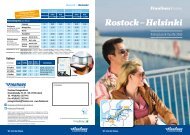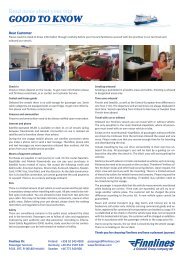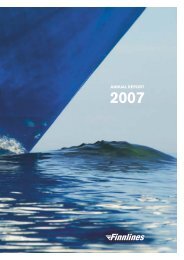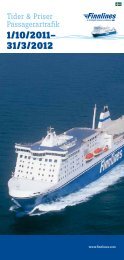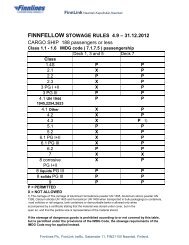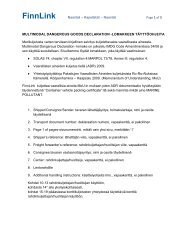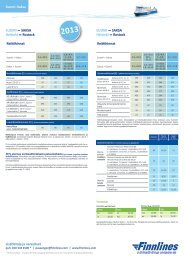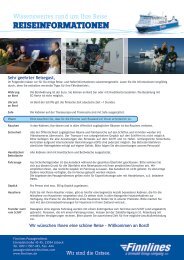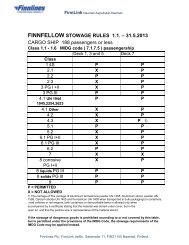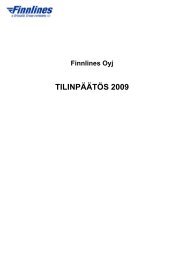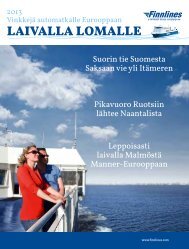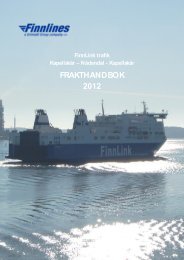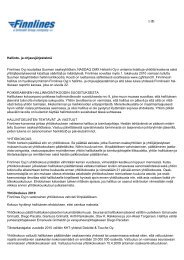FINANCIAL STATEMENTS 2010 - Finnlines
FINANCIAL STATEMENTS 2010 - Finnlines
FINANCIAL STATEMENTS 2010 - Finnlines
You also want an ePaper? Increase the reach of your titles
YUMPU automatically turns print PDFs into web optimized ePapers that Google loves.
ated companies are consolidated using the equity method. If<br />
the Group's share of associated companies' losses exceeds the<br />
book value of the investment, the investment is recognised in the<br />
statement of financial position at zero value and the portion of the<br />
losses exceeding the book value is not consolidated unless the<br />
Group has agreed to meet the associated companies' obliga-<br />
tions. Unrealised profits between the Group and its associated<br />
companies are eliminated to the extent of the Group's share of<br />
ownership.<br />
NON-CURRENT ASSETS (OR DISPOSAL GROUPS) HELD FOR<br />
SALE AND DISCONTINUED OPERATIONS<br />
Non-current assets (or disposal groups) are classified as assets<br />
held for sale when their carrying amount is to be recovered prin-<br />
cipally through a sale transaction and a sale is considered highly<br />
probable. They are stated at the lower of carrying amount or fair<br />
value less costs to sell if their carrying amount is to be recovered<br />
principally through a sale transaction rather than through continu-<br />
ing use.<br />
A discontinued operation represents a separate major line of<br />
business, or geographical area, which has been disposed of or is<br />
classified as held for sale.<br />
TRANSLATION OF FOREIGN CURRENCY ITEMS<br />
The items in each Group unit's accounts are valued in the princi-<br />
pal currency of the operating environment of the unit in question<br />
(the “functional currency”). The functional currency of the subsid-<br />
iaries is the official currency used in the location country except<br />
in Sweden, where the functional currency used is EUR. The Con-<br />
solidated Financial Statements are presented in EUR, which is<br />
the parent company's functional and presentation currency.<br />
Transactions in foreign currencies are recognised at the ex-<br />
change rate valid on the transaction date. Monetary items de-<br />
nominated in foreign currencies are translated into EUR at the<br />
exchange rates valid at the end of the reporting period. Non-mon-<br />
etary items denominated in foreign currencies and valued at their<br />
fair value are translated into EUR at the exchange rates valid on<br />
the date of valuation. Other non-monetary items are valued using<br />
the exchange rate valid on the transaction date. Profits and loss-<br />
es arising from foreign currency valued transactions and transla-<br />
tion of foreign currency valued monetary items are recognised<br />
in the profit and loss account. Exchange rate differences arising<br />
from transaction translations are included under result before in-<br />
terest and taxes in the profit and loss account, whereas exchange<br />
rate differences arising from financial assets and liabilities are in-<br />
cluded under financial items. Profits and losses arising from the<br />
translation of loans in foreign currencies are recognised under fi-<br />
nancial income and expenses.<br />
The profit and loss accounts of subsidiaries located outside<br />
the euro area are translated into EUR using weighted average<br />
exchange rates. Statement of financial positions are translated<br />
at the exchange rate prevailing on the end of the reporting pe-<br />
riod. Translation differences arising from investment in foreign<br />
units are recognised under shareholders' equity. Translation dif-<br />
(figures in EUR thousand, if not stated otherwise)<br />
ferences arising from shareholders' equity items emerging from<br />
the elimination of foreign subsidiaries' acquisition costs after the<br />
acquisition are recognised under shareholders’ equity. When a<br />
subsidiary is wholly or partly sold, cumulative translation differ-<br />
ences are recognised in the profit and loss account as part of the<br />
profit or loss from the sale of the subsidiary. Translation differenc-<br />
es arising prior to 1 January 2004 were transferred to retained<br />
earnings on the date of transition to IFRS. They will not be recog-<br />
nised in the profit and loss account on the sale of the subsidiar-<br />
ies in question. Translation differences arising after the transition<br />
date during the creation of the Consolidated Financial State-<br />
ments are listed as a separate item under shareholders' equity.<br />
PROPERTY, PLANT AND EQUIPMENT<br />
Fixed assets are valued at their direct acquisition cost, deducted<br />
by depreciation and impairments. The acquisition cost includes<br />
direct expenses incurred in the acquisition. Significant renova-<br />
tion and overhaul expenses arising at a later date are included in<br />
each asset’s book value. They can be recognised as a separate<br />
asset only if it is likely that the future economic benefits associat-<br />
ed with the item will be beneficial to the Group and if the acquisi-<br />
tion cost of the asset can be reliably determined. Ordinary repair<br />
and maintenance expenses are recognised as expenses for the<br />
reporting period during which they were incurred.<br />
Fixed assets are depreciated according to plan, based on the<br />
estimated useful life of the asset. Land is not depreciated. The<br />
estimated useful lives are as follows:<br />
Vessels 30-35 years<br />
Buildings 10-40 years<br />
Constructions 5-10 years<br />
Stevedoring machinery and equipment 5-25 years<br />
Light machinery and equipment 3-10 years<br />
Second-hand vessels are depreciated over their estimated useful<br />
lives. The estimated useful lives and the residual values of assets<br />
are revised on each end of the reporting period and, when nec-<br />
essary, adjusted to reflect changes that have taken place in the<br />
expected future economic benefits.<br />
The depreciation on a tangible asset stops when the asset<br />
is classified as being held for sale in accordance with the IFRS<br />
5 standard (Non-current Assets Held for Sale and Discontin-<br />
ued Operations). Gains and losses on retirement and disposal of<br />
tangible assets are recognised under other income or expenses<br />
from operations.<br />
If the book value of an asset exceeds its current recoverable<br />
amount, the value of the asset is written off to correspond to its<br />
recoverable amount. Any interest and deposit charges from long-<br />
term projects for the construction of tangible assets are capital-<br />
ised as part of the fixed assets. Other interest expenses incurred<br />
in relation to asset purchases are recognised as expenses for the<br />
reporting period during which they were incurred.<br />
FINNLINES PLC Financial Statements <strong>2010</strong><br />
13



